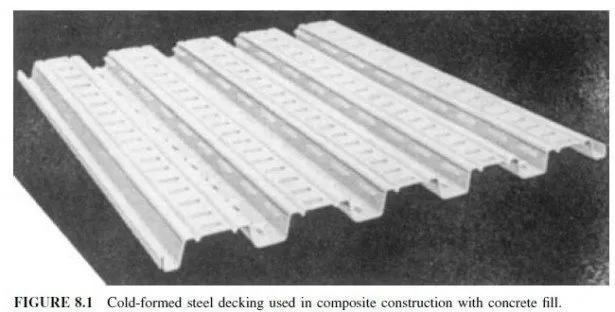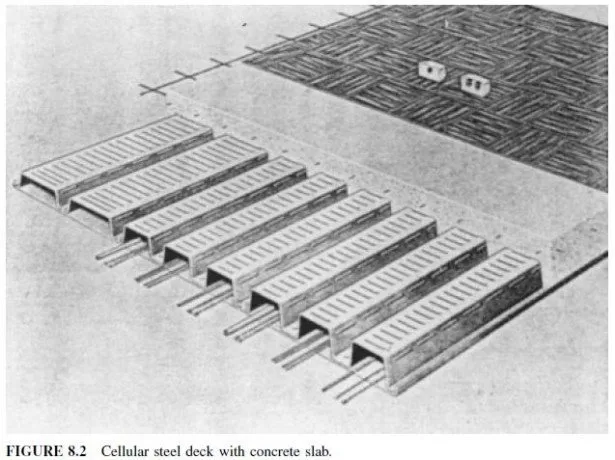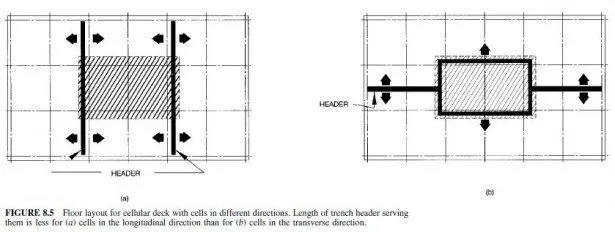The most prevalent type of floor deck used with steel frames is concrete fill on metal deck. The metal deck consists of cold-formed profiles made from steel sheet, usually having a yield strength of at least 33 ksi. Design requirements for metal deck are contained in the American Iron and Steel Institutes Specification for the Design of Cold-Formed Steel Structural Members.
The concrete fill is usually specified to have a 28-day compressive strength of at least 3000 psi. Requirements for concrete design are contained in the American Concrete Institute Standard ACI 318, Building Code Requirements for Reinforced Concrete. Sheet thicknesses of metal deck usually range between 24 and 18 ga, although thicknesses outside this range are sometimes used. The design thicknesses corresponding to typical gage designations are shown in Table 8.1.
Metal deck is commonly available in depths of 11â„2, 2, and 3 in. Generally, it is preferable to use a deeper deck that can span longer distances between supports and thereby reduce the number of beams required. For example, a beam spacing of about 15 ft can be achieved with 3-in deck. However, each project must be evaluated on an individual basis to determine the most efficient combination of deck depth and beam spacing.
For special long-span applications, metal deck is available with depths of 41â„2, 6, and 71â„2 in from some manufacturers.
Composite versus Noncomposite Construction. Ordinarily, composite construction with metal deck and structural-steel framing is used. In this case, the deck acts not only as a permanent form for the concrete slab but also, after the concrete hardens, as the positive bending reinforcement for the slab. To achieve this composite action, deformations are formed in the deck to provide a mechanical interlock with the concrete (Fig. 8.1). Although not serving a primary structural purpose, welded wire fabric is usually placed within the concrete slab about 1 in below the top surface to minimize cracking due to concrete shrinkage and thermal effects. This welded wire fabric also provides, to a limited degree, some amount of crack control in negative-moment regions of the slab over supporting members.
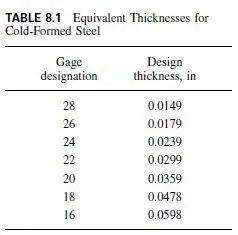
Noncomposite metal deck is used as a form for concrete and is considered to be ineffective in resisting superimposed loadings. In cases where the deck is shored, or where the deck is unshored but the long-term reliability of the deck will be questionable, the deck is also considered to be ineffective in supporting the dead load of the concrete slab. For example, in regions where deicing chemicals are applied to streets, metal deck used in parking structures is susceptible to corrosion and may eventually be ineffective unless special precautions are taken. In such cases, the metal deck should be used solely as a form to support the concrete until it hardens. Reinforcement should be placed within the slab to resist all design loadings.
Noncellular versus Cellular Deck. It is sometimes desirable to distribute a buildings electrical wiring within the floor deck system, in which case cellular metal deck can be used in lieu of noncellular deck. However, in cases where floor depth is not critical, maximum wiring flexibility and capacity can be attained by using a raised access floor above the structural floor deck.
Cellular deck is essentially noncellular deck, such as that shown in Fig. 8.1, with a flat sheet added to the bottom of the deck to create cells (Fig. 8.2). Electrical, power, and telephone wiring is placed within the cells for distribution over the entire floor area. In many cases, a sufficient number of cells is obtained by combining alternate panels of cellular deck and noncellular deck, which is called a blended system (Fig. 8.3). When cellular deck is used, the 3-in depth is the minimum preferred because it provides convenient space for wiring. The 11â„2-in depth is rarely used.
For feeding wiring into the cells, a trench header is placed within the concrete above the metal deck, in a direction perpendicular to the cells (Fig. 8.4). Special attention should be given to the design of the structural components adjacent to the trench header, since composite action for both the floor deck and beams is lost in these areas. Where possible, the direction of the cells should be selected to minimize the total length of trench header required. Generally, by running the cells in the longitudinal direction of the building, the total length of trench header is significantly less than if the cells were run in the transverse direction (Fig. 8.5).
If a uniform grid of power outlets is desired, such as 5 ft by 5 ft on centers, preset outlets can be positioned above the cells and cast into the concrete fill. However, in many cases the outlet locations will be dictated by subsequent tenant layouts. In such cases, the concrete fill can be cored and afterset outlets can be installed at any desired location.
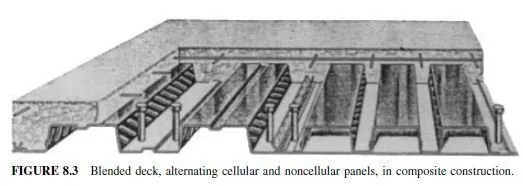
Shored versus Unshored Construction. To support the weight of newly placed concrete and the construction live loads applied to the metal deck, the deck can either be shored or be designed to span between supporting members. If the deck is shored, a shallower-depth or thinner-gage deck can be used. The economy of shoring, however, should be investigated, inasmuch as the savings in deck cost may be more than offset by the cost of the shoring.
Also, slab deflections that will occur after the shoring is removed should be evaluated, as well as concrete cracking over supporting members. Another consideration is that use of shoring can sometimes affect the construction schedule, since the shoring is usually kept in place until the concrete fill has reached at least 75% of its specified 28-day compressive strength. In addition, when shoring is used, the concrete must resist the stresses resulting from the total dead load combined with all superimposed loadings.
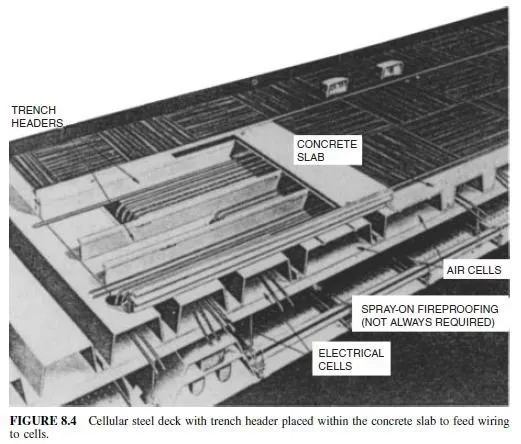
When concrete is cast on unshored metal deck, the weight of the concrete causes the deck to deflect between supports. This deflection is usually limited to the lesser of 1â„180 the deck span or 3â„4 in. If the resulting effect on floor flatness is objectionable, the top surface can be finished level, but this will result in additional concrete being placed to compensate for the deflection. The added weight of this additional concrete must be taken into account in design of the metal deck to ensure adequate strength. The concrete fill, however, need only resist the stresses resulting from superimposed loadings.
Unshored metal-deck construction is the system most commonly used. The additional cost of the deeper or thicker deck is generally much less than the cost of shoring. To increase the efficiency of the unshored deck in supporting the weight of the unhardened concrete and construction live loads, from both a strength and deflection standpoint, the deck is normally extended continuously over supporting members for two or three spans, in lieu of singlespan construction. However, for loadings once the concrete is hardened, the composite slab is designed for the total load, including slab self-weight, with the slab treated as a single span, unless negative-moment reinforcement is provided over supports in accordance with conventional reinforced-concrete-slab design (disregarding the metal deck as compressive reinforcement).
Lightweight versus Normal-Weight Concrete. Either lightweight or normal-weight concrete can serve the structural function of the concrete fill placed on the metal deck. Although there is a cost premium associated with lightweight concrete, sometimes the savings in steel framing and foundation costs can outweigh the premium. Also, lightweight concrete in sufficient thickness can provide the necessary fire rating for the floor system and thus eliminate the need for additional slab fire protection (see Fire Protection below).
The tradeoffs in use of lightweight concrete versus normal-weight concrete plus fire protection should be evaluated on a project-by-project basis.
Fire Protection. Most applications of concrete fill on metal deck in buildings require that the floor-deck assembly have a fire rating. For noncellular metal deck, the fire rating is usually obtained either by providing sufficient concrete thickness above the metal deck or by applying spray-on fire protection to the underside of the metal deck. For cellular metal deck, which utilizes outlets that penetrate the concrete fill, the fire rating is usually obtained by the latter method. As an alternative, a fire-rated ceiling system can be installed below the cellular or noncellular deck.
When the required fire rating is obtained by concrete-fill thickness alone, lightweight concrete requires a lesser thickness than normal-weight concrete for the same rating. For example, a 2-hour rating can be obtained by using either 31â„4 in of lightweight concrete or 41â„2 in of normal-weight concrete above the metal deck. The latter option is rarely used, since the additional thickness of heavier concrete penalizes the steel tonnage (i.e., heavier beams, girders, and columns) and the foundations.
If spray-on fire protection is used on the underside of the metal deck, the thickness of concrete above the deck can be the minimum required to resist the applied floor loads. This minimum thickness is usually 21â„2 in, and the less expensive normal-weight concrete may be used instead of lightweight concrete. Therefore, the two options that are frequently considered for a 2-hour-rated, noncellular floor-deck system are 31â„4-in lightweight concrete above the metal deck without spray-on fire protection and 21â„2-in normal-weight concrete above the metal deck with spray-on fire protection (Fig. 8.6). Since the dead load of the floor deck for the two options is essentially the same, the steel framing and foundations will also be the same. Thus, the comparison reduces to the cost of the more expensive lightweight concrete versus the cost of the normal-weight concrete plus the spray-on fire protection. Since the costs, and contractor preferences, vary with geographical location, the evaluation must be made on an individual project basis. (See also Art. 6.32.)
Diaphragm Action of Metal-Deck Systems. Concrete fill on metal deck readily serves as a relatively stiff diaphragm that transfers lateral loads, such as wind and seismic forces, at each floor level through in-plane shear to the lateral load-resisting elements of the structure, such as shear walls and braced frames. The resulting shear stresses can usually be accommodated by the combined strength of the concrete fill and metal deck, without need for additional reinforcement. Attachment of the metal deck to the steel framing, as well as attachment between adjacent deck units, must be sufficient to transfer the resulting shear stresses (see Attachment of Metal Deck to Framing below).
Additional shear reinforcement may be required in floor decks with large openings, such as those for stairs or shafts, with trench headers for electrical distribution, or with other shear discontinuities. Also, floors in multistory buildings in which cumulative lateral loads are transferred from one lateral load-resisting system to another (for example, from perimeter frames to interior shear walls), may be subjected to unusually large shear stresses that require a diaphragm strength significantly greater than that for a typical floor.
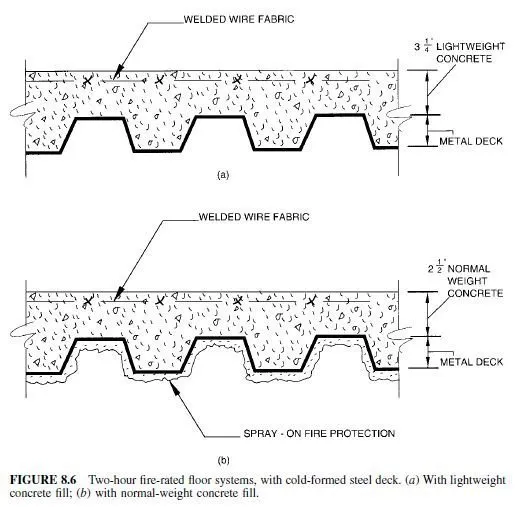
Attachment of Metal Deck to Framing. Metal deck can be attached to the steel framing with puddle (arc spot) welds, screws, or powder-driven fasteners. These attachments provide lateral bracing for the steel framing and, when applicable, transfer shear stresses resulting from diaphragm action. The maximum spacing of attachments to steel framing is generally 12 in.
Attachment of adjacent deck units to each other, that is, sidelap connection, can be made with welds, screws, or button punches. Generally, the maximum spacing of sidelap attachments is 36 in. In addition to diaphragm or other loading requirements, the type, size, and spacing of attachments is sometimes dictated by insurance (Factory Mutual or Underwriters Laboratories) requirements.
Weld sizes generally range between 1â„2-in and 3â„4-in minimum visible diameter. When metal deck is welded to steel framing, welding washers should be used if the deck thickness is less than 22 ga to minimize the possibility of burning through the deck. Sidelap welding is not recommended for deck thicknesses of 22 ga and thinner.
Screws can be either self-drilling or self-tapping. Self-drilling screws have drill points
and threads formed at the screw end. This enables direct installation without the need for
predrilling of holes in the steel framing or metal deck. Self-tapping screws require that a hole be drilled prior to installation. Typical screw sizes are No. 12 and No. 14 (with 0.216- in and 0.242-in shank diameter, respectively) for attachment of metal deck to steel framing.
No. 8 and No. 10 screws (with 0.164-in and 0.190-in shank diameter, respectively) are frequently used for sidelap connections.
Powder-driven fasteners are installed through the metal deck into the steel framing with pneumatic or powder-actuated equipment. Predrilled holes are not required. These types of fasteners are not used for sidelap connections.
Button punches can be used for sidelap connections of certain types of metal deck that utilize upstanding seams at the sidelaps. However, since uniformity of installation is difficult to control, button punches are not usually considered to contribute significantly to diaphragm strength.
The diaphragm capacity of various types and arrangements of metal deck and attachments are given in the Steel Deck Institute Diaphragm Design Manual.
